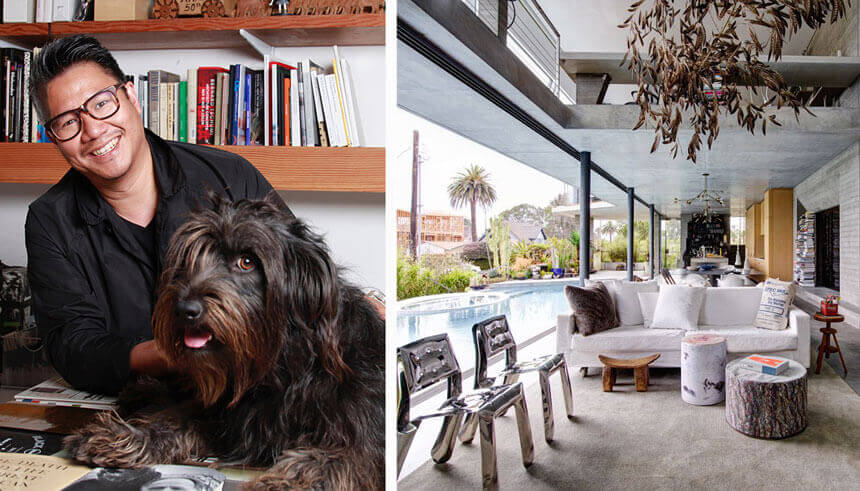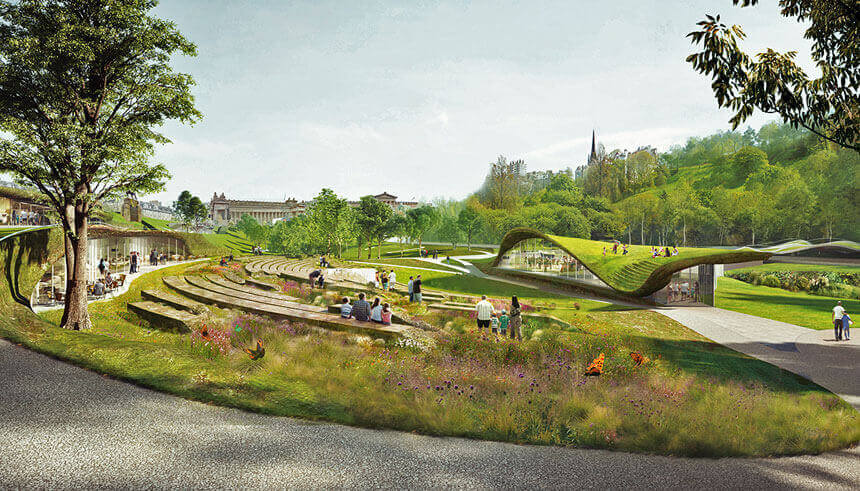JULY 27, 2020 | Reach Further
For more articles and related content, visit East West Bank’s digital business publication, Reach Further.

The architect Kulapat Yantrasast at his home in Venice, California
World-renowned architect Kulapat Yantrasast talks about how the pandemic will impact design in the future.
“I'm definitely thinking deeply about spirit and human connection,” Kulapat Yantrasast says, after three and a half months of quarantine at his home in Venice, California.
The lockdown has been a time of reflection for the prolific architect and East West Bank client, whose company, wHY, was named one of the world’s top 100 design firms by Architectural Digest this year. At any given time, his staff is juggling 50 or so projects around the world, such as the renovation of the Rockefeller Wing of the Metropolitan Museum of Art, construction of the new Tchaikovsky Academic Opera and Ballet Theater in Russia, and Ross Pavilion, an outdoor music venue and park in Edinburgh, Scotland. wHY’s design for the Grand Rapids Art Museum in Michigan helped spur an urban revitalization of the downtown area and was the first LEED Gold certified museum in the world. He also spearheaded the renovation of the Marciano Art Foundation in Los Angeles.
Yantrasast talks with us about the kinds of effects he thinks the pandemic will have on design and architecture.
In what ways do you think design will have to adapt to the coronavirus?
Design is not merely decoration. Design is fundamentally the “how" of life. I think that the pandemic has really forced us to redefine life in general: how we work together, how we live; what does home look like, what does office look like, what does a city look like? All of these questions are now put on our shoulders as the people living in this time to redefine, not to try to go back to what was, but to go on to create something better, something spiritual, that allows us to live even more fully. The fear of human contact will continue to go on for years—so how do we bring a world where everyone wants to be together? Restoring that human connection which we are all missing is definitely central to my mind.

Grand Rapids Art Museum
Are there certain aspects of design that you weren't really thinking about before, that you're thinking more about now?
It's not the first time in history that a pandemic of such a magnitude disrupted work and life. If you look at the time period around the Spanish flu, new paradigms for design innovation happened around that shift. For example, the highly influential Bauhaus movement emerged out of this time. So, I think we could look back in history and learn from those moments, and see how intelligent and creative people reacted to crisis. That's what we look at the most, is the idea of how architecture can empower peoples and help them flourish. That's our motto; that's our vision.
Architecture has the power to make people's lives better. From the wealthiest to the poorest people, architecture plays a role that affects everyone. So, what happened this year was not only the pandemic, but also a massive drive for social justice and equality, and I think architecture has a role to play in all of that. So, I would like us to be mindful, not only just as a design solution provider but also as an active social thinker. Art and architecture might not directly change the world, but architecture will impact the minds of the people who will change the world.
That's interesting because you don't normally associate social movements with architecture. What kind of role do you think architecture can play?
Architecture has power. We’ve all gone to churches, parliaments and temples and know that feeling of awe when you're in the presence of great spaces and architecture. In modern times, architecture has been used to glorify billionaires, dictators, governments or architect’s egos and many other things, and yet architecture could also glorify humanity and communities. And that's something that we need to work harder at, because it's easier to glorify one person; it's very difficult to glorify diversity or a sense of unity and equality.
You look at institutional buildings, like a courthouse entrance with an imposing staircase. That architecture is trying to establish a sense of authority over people. Even some museums are designed with that kind of language. So, this already divides; for minorities and other disenfranchised people, you know by instinct that this is a place that will not only judge you, but may also discriminate against you. So that's the kind of architecture we want to avoid. At the same time, when you look at spaces that allow people to flourish, that makes you feel happy and elevated, whether it's a beautiful garden with a courtyard, a plaza of a small town, a barn or something that's open, where everyone can see one another, a place that celebrates privacy and individualism, yet also encourages community and a sense of togetherness. I think those are the kinds of spaces I'm interested in.

Is there a project you’re working on that captures this kind of feel that you're talking about, this openness and community?
Our competition-winning design for the Ross Pavilion and park in Edinburgh, Scotland, is an integration of architecture and landscape in the fullest sense, and we're just about to start the construction of phase two. That's a great example of how in our own words we walk our talk, by creating places that celebrate nature and people coming together to enjoy music and art as a way of inspiring people in their everyday life.
We have a very integrated design practice: We have architecture, landscape, museums, objects and ideas, and work together holistically on all those aspects. When we're designing architecture, we're thinking about the garden, we’re thinking about urban spaces, we’re thinking about furniture and technology. We think holistically about everything, so we’re not just in the business of designing a hollow space. The idea is that you design something that everything has a life in it and will continue to grow. Like planting a garden, it will continue to grow and evolve, based on ecology. That is, I think, the ultimate focus of design.

